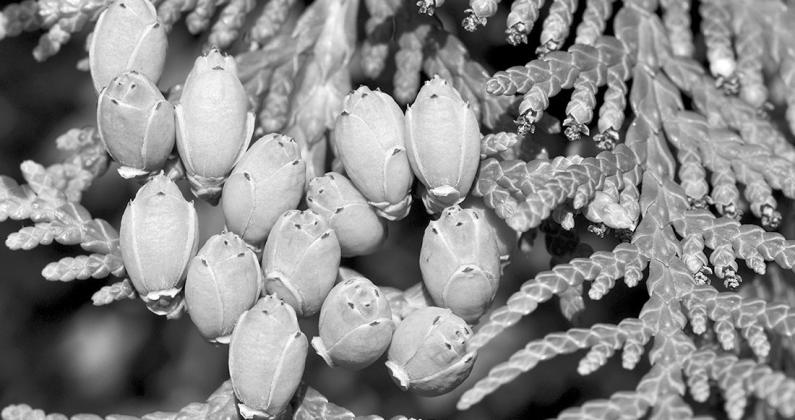Thuja spp. - Cedar scent is from antimicrobial essential oils
Thuja orientalis, T. occidentalis and other trees in the Thuja genus are evergreen conifers called arborvitae. Other names are thuja, western red cedar, white cedar, etc. Their conical shape stays neat with little or no pruning making them popular in landscapes. They are slow-growing and long-lived with some living hundreds of years. Depending on species and variety they can be from 4 to more than 100 feet tall. They are often shaped like a traditional Christmas tree.
Because of arborvitae’s essential oils, the plant smells like cedar or camphor or pine, making the wood resistant to decay and insect damage. It’s used for cabin logs, paneling, furniture, shingles, fences, canoes, storage containers, etc. It’s good for items that come in contact with soil and water. Because of its high oil content, the bark was rolled and lighted as a torch.
Its flat opposite leaves overlap like scales. Conifer flowers are called strobili, “small cones”. Male and female cones are usually on the same tree. Female cones are egg-shaped, usually green, about ½ inch long. Male cones, found on leaf tips, are reddish-green to brown and much smaller. When mature they release yellow pollen grains.
Thuja is from the Greek word “thuo”, meaning “to sacrifi ce”. The wood was burned during some sacrificial ceremonies. In the mid-16th century French explorers were saved from scurvy, a disease caused by lack of vitamin C. They were cured when Native Americans gave them soup and tea made from the tree’s leaves and twigs now known to be high in vitamin C. The tree was sent to Europe becoming one of the first North American trees introduced there. Because it had saved the explorers’ lives, the tree was called “arbor vitae”, Latin for “tree of life”.
Arborvitae is an antioxidant with antimicrobial, anti- inflammatory, and other properties used by traditional, homeopathic and allopathic (mainstream) medicine systems including aromatherapy. It treats colds and other respiratory problems, fevers, headaches, toothaches, prostate, women’s issues, parasitic worms, etc. Arborvitae was mixed with animal fat to create a salve that treated rheumatism and skin conditions.
Following are articles from the National Institutes of Health, ncbi.nlm.nih.gov.
• “Antimicrobial activity of the essential oil of Thuja orientalis L.”.
• “Thuja orientalis reduces airway inflammation in ovalbumin-induced allergic asthma”.
(The protein “ovalbumin” is about 55% of egg white protein.)
• “Free radical scavenging and antielastase activities of flavonoids from the fruits of Thuja orientalis”.
Native Americans made smudges out of smoldering arborvitae to ward off evil spirits. Because we now know that the essential oil kills microbes, it is used in room sprays, disinfectants, cleansers, soap, insecticides, etc. It’s added to paints to protect against mites and rodents. Its scent is used in perfume especially men’s cologne.
Texas A&M University has an interesting article by William C. Welch at aggie- horticulture.tamu.edu. The title is “Landscaping for Energy Conservation”. T. orientalis is listed in the section “Selecting Species for Windbreaks”.
B_ D __ _ R__._ ____


